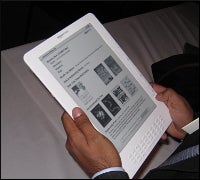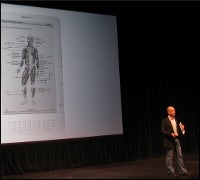 The new Amazon Kindle DX. Click to enlarge. |
NEW YORK — Amazon today unveiled a new version of its popular Kindle e-book reader, sporting enhancements like an enlarged screen designed for reading standard 8.5-by-11-inch documents, textbooks and newspapers.
The new Kindle DX, introduced here at Pace University by Amazon (NASDAQ: AMZN) CEO Jeff Bezos, is aimed at broadening the appeal of the company’s Kindle e-book reader.
While the Kindle has already proven a hit with a six-inch screen — more than 275,000 book titles are now available for the device, Bezos said — he added that the Kindle’s design has excluded it from some kinds of use.
Office documents, for one thing.
“Most of the documents that we print and read are 8.5 by 11 [inches] — the information on those documents is structured to be read at 8.5 by 11. There are complex layouts,” he said. “It’s not only personal documents … it’s any highly structured document. There are many kinds of books that have really complex layouts.”
“Even with electronic paper, you need a big display,” he added.
That’s a problem Amazon aims to solve courtesy of the Kindle DX’s larger, 9.7-inch screen size.
The device’s expanded display also makes it appealing for books that rely on large, complex graphics, tables and other layout elements that are difficult to translate to a smaller screen, Bezos said.
“With the Kindle DX … you never have to pan, never have to zoom, never have to scroll,” he said, during a demonstration in which the device displayed pages from a wide range of books, including cookbooks and scientific textbooks. “You just read the documents.”
Several other enhancements are also designed to improve reading of textbooks and newspapers. The Kindle DX now includes a widescreen mode: Turn the device to the side, and the screen rotates — similarly to the widescreen mode common on devices like the Apple iPhone. The unit also includes native support for PDF files.
The Kindle DX is slated to begin shipping in summer with a $489 price tag, Bezos said. Amazon is also now accepting pre-orders for the unit.
Heated competition
The introduction — rumors of which had been circulating for some time — marks the second major shift in the Kindle product lineup this year. In February, Amazon unveiled the Kindle 2, an update of the original device with a slimmer profile and more advanced reading display.
Both the Kindle 2 and Kindle DX launches come amid growing competition in the e-book space, which has seen Google partner with Sony to provide the electronics giant’s e-reader with access to Google’s library of scanned public-domain titles.
Meanwhile, Barnes & Noble is widely expected to launch a rival e-book reader of its own.
It’s also no wonder why so many parties are now vying for a portion of the e-book market. While Amazon is tight-lipped about how much money it makes from the Kindle, industry observers estimated earlier this year that Amazon could rake in $1.2 billion from sales related to its e-reader during 2010.
Newspapers and textbooks
To give the Kindle’s latest addition a head start out of the gate, Amazon has also been busily lining up content partners for the new device. Bezos announced partnerships with three of the largest textbook publishers — Pearson, Cengage Learning and Wiley — who together are responsible for about 60 percent of the college textbooks in use today.
Bezos also said that a number of U.S. universities had signed on as pilot partners to give the device a test-drive on campus. Arizona State University, Case Western Reserve University, Princeton University, Reed College, and Darden School of Business at the University of Virginia will begin offering the e-reader to incoming students. It’s not yet clear who will be paying for the devices, however.
 Amazon CEO Jeff Bezos demos the new Amazon Kindle DX. Click to enlarge. |
“We’re going to get students with smaller backpacks, less load, smaller access,” he said.
Newspapers, although they’re available for the current-generation Kindle — represent another field in which Kindle DX can make a difference, Bezos said.
“Newspapers have been an absolute bestseller on Kindle — people love waking up in the morning to find that their New York Times, their Washington Post, their Wall Street Journal have been automagically delivered overnight.”
He also announced pilot programs with two of the nation’s largest newspapers publishers: the New York Times Company and Washington Post Company. As a result of those deals, the New York Times, the Times-owned Boston Globe and the Washington Post will be experimenting with new subscription models based around the device.
“They’re going to offer Kindle DX for a reduced price in exchange for long-term commitments for subscriptions,” Bezos said. He did not disclose further details of the effort.
Page 2: Newspapers bet on Kindle DX
Page 2 of 2
Arthur Sulzberger, Jr., chairman of the New York Times Company, joined Bezos on stage to highlight a new subscription plan that will see the New York Times and Boston Globe offering discounted Kindle DXes to subscribers that live outside of the papers’ home delivery areas.
“We’ve known for more than a decade that an e-reader product would offer the same satisfying experience as the printed newspaper,” Sulzberger said. “As each new generation of the Kindle came to market, that dream has and does continue to get closer.”
For publishers like the New York Times Company (NYSE: NYT), the Kindle represents another way in which a traditionally print business is moving to adopt new models, he said.
The move also comes as the Times, as well as newspapers throughout the country, are struggling with dwindling revenue as readers and advertisers turn online.
“We are using every available medium to meet the ever-growing demand for high-quality journalism across all platforms,” he said. “This experiment, and our entire e-reader collaboration with Amazon, demonstrates our commitment to reinvention and to taking full advantage of digital media.”
While Sulzberger said the Boston Globe would be included in the pilot marketing program with Amazon, the New York Times Company had been threatening to shutter the embattled paper if its key unions didn’t agree to pay cuts and other cost-savings measures. The paper’s seven unions reached a deal with the company earlier today, according to reports.
The worsening publishing climate has also ensured that the Washington Post Company (NYSE: WPO) and New York Times Company aren’t the only ones making moves into electronic devices.
The Detroit Free Press and the Detroit News recently announced plans to partner with Plastic Logic, a startup planning to enter the e-book reader business — citing the large screen size of the firm’s e-reader as a deciding factor.
While the Plastic Logic Reader is still months away from its pilot programs, the unit’s features will rival those of the Kindle DX when it ships. For one thing, it offers a form factor that’s also the size of an 8.5-by-11-inch piece of paper. The e-reader also is slated to have a touchscreen interface, among other yet-to-be-announced features, according to a statement from Plastic Logic.
Also similar to Amazon’s work with the Washington Post, Boston Globe and New York Times, the agreement with the two Detroit-based newspapers will see the Plastic Logic Reader being offered for purchase or lease to their subscribers as an alternative to paper delivery.
In addition to the Detroit Free Press and the Detroit News, Plastic Logic has said it has agreements in place to sell content from publishers including the Financial Times, USA Today and content aggregators like Ingram Digital, LibreDigital, and Zinio.


